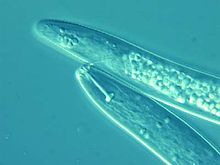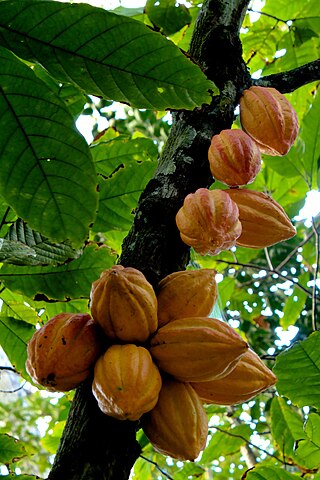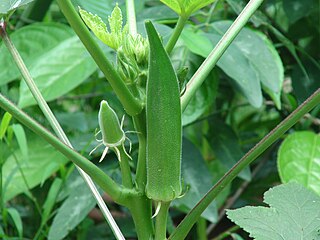Bacterial diseases
| Bacterial diseases | ||
|---|---|---|
| Crown gall | Agrobacterium tumefaciens (artificial inoculations) |  |
| Stripe | Pectobacterium carotovorum |  |
Like other crops cocoa can be attacked by a number of pest species including fungal diseases, insects and rodents - some of which (e.g. frosty pod rot and cocoa pod borer) have increased dramatically in geographical range and are sometimes described as "invasive species". [1]
| Bacterial diseases | ||
|---|---|---|
| Crown gall | Agrobacterium tumefaciens (artificial inoculations) |  |
| Stripe | Pectobacterium carotovorum |  |
| Miscellaneous diseases | ||
|---|---|---|
| Algal disease | Cephaleuros virescens |  |
| Cherelle wilt | Physiological, no specific pathogen involved | |
| Nematodes, parasitic | |||
|---|---|---|---|
| Awl nematode | Dolichodorus spp. | ||
| Cyst nematode | Heterodera spp. |  | |
| Dagger nematode | Xiphinema spp. |  | |
| Lesion nematode | Pratylenchus spp. |  | |
| Reniform nematode | Rotylenchulus spp. |  | |
| Ring nematode | Hoplolaimus spp. | ||
| Root-knot nematode | Meloidogyne spp. |  | |
| Spiral nematode | Helicotylenchus spp. |  | |
| Stubby root nematode | Trichodorus spp. |  | |
| Mistletoes | |
|---|---|
| Dendrophthora spp. |  |
| Loranthus spp. |  |
| Oryctanthus spp. |  |
| Phoradendron spp. |  |
| Phthirusa spp. |  |
| Tapinanthus spp. |  |
| Viral and viroid diseases | ||
|---|---|---|
| Cacao swollen shoot virus (CSSV) |  | |
| Cacao yellow mosaic virus (CYMV) | ||
| Cocoa necrosis virus (CNV) | ||

The cocoa bean or simply cocoa, also called cacao, is the dried and fully fermented seed of Theobroma cacao, from which cocoa solids and cocoa butter can be extracted. Cocoa beans native to the Amazon rainforest are the basis of chocolate, and Mesoamerican foods including tejate, an indigenous Mexican drink.

Theobroma cacao is a small evergreen tree in the family Malvaceae. Its seeds, cocoa beans, are used to make chocolate liquor, cocoa solids, cocoa butter and chocolate. Native to the tropics of the Americas, the largest producer of cocoa beans in 2018 was Ivory Coast, at 2.2 million tons.

The mung bean, alternatively known as the green gram, maash ٫ mūng, monggo, đậu xanh, kacang hijau or munggo (Philippines), is a plant species in the legume family. The mung bean is mainly cultivated in East, Southeast and South Asia. It is used as an ingredient in both savoury and sweet dishes.

The cowpea is an annual herbaceous legume from the genus Vigna. Its tolerance for sandy soil and low rainfall have made it an important crop in the semiarid regions across Africa and Asia. It requires very few inputs, as the plant's root nodules are able to fix atmospheric nitrogen, making it a valuable crop for resource-poor farmers and well-suited to intercropping with other crops. The whole plant is used as forage for animals, with its use as cattle feed likely responsible for its name.

The Pyralidae, commonly called pyralid moths, snout moths or grass moths, are a family of Lepidoptera in the ditrysian superfamily Pyraloidea. In many classifications, the grass moths (Crambidae) are included in the Pyralidae as a subfamily, making the combined group one of the largest families in the Lepidoptera. The latest review by Eugene G. Munroe and Maria Alma Solis retain the Crambidae as a full family of Pyraloidea.

Okra, Abelmoschus esculentus, known in some English-speaking countries as lady's fingers, is a flowering plant in the mallow family. It has edible green seed pods. The geographical origin of okra is disputed, with supporters of West African, Ethiopian, Southeast Asian, and South Asian origins. Cultivated in tropical, subtropical, and warm temperate regions around the world, okra is used in the cuisines of many countries.

Ostrinia is a genus of moths in the family Crambidae described by Jacob Hübner in 1825. Several of them, including the European corn borer, are agricultural pests.

Maruca vitrata is a pantropical insect pest of leguminous crops like pigeon pea, cowpea, mung bean and soybean. Its common names include the maruca pod borer, bean pod borer, soybean pod borer, mung moth, and the legume pod borer. The species was first described by Johan Christian Fabricius in 1787.

Etiella zinckenella, the pulse pod borer moth, is a moth of the family Pyralidae. It is found in southern and eastern Europe and in the tropics and subtropics of Africa and Asia. They have also been introduced to North America and Australia. It is usually a minor pest for many legumes, but can be a serious pest.

Conopomorpha cramerella, the cocoa pod borer, is a moth of the family Gracillariidae. It is known from Saudi Arabia, China, India, Thailand, Brunei, Indonesia, Malaysia, Vietnam, Australia, New Britain, the Philippines, Samoa, the Solomon Islands, Sri Lanka, Taiwan and Vanuatu.
Carmenta theobromae, the cocoa fruit borer, is a moth of the family Sesiidae. It was described by August Busck in 1910, and is known from Colombia and Venezuela.

Polyphagozerra coffeae, the red coffee borer or coffee carpenter, is a moth of the family Cossidae. It was described by John Nietner in 1861 and is found in Asia. Records from the Moluccas and New Guinea refer to Polyphagozerra reticulata, which was previously considered to be a synonym of P. coffeae. It is a widespread pest that attacks many plants.
The environmental impact of cocoa production includes deforestation, soil contamination, and herbicide resistance. The majority of cocoa farms are now located in Côte d'Ivoire and Ghana.

The genus Helopeltis, also known as mosquito bugs, is a group of Heteropterans in the family Miridae and tribe Dicyphini. They include important pests of various crops, including cacao, cashew, cotton and tea. Now in a different subgenus, a number of similar Afropeltis species are pests in Africa.
Black pod disease is a protozoal disease of Cocoa trees. This pathogen if left untreated can destroy all yields; annually the pathogen can cause a yield loss of up to 1/3 and up to 10% of total trees can be lost completely.

Euwallacea fornicatus is a species complex consisting of multiple cryptic species of ambrosia beetles, known as an invasive species in California, Israel and South Africa. The species has also been unintentionally introduced into exotic greenhouses in several European countries. As the rest of the ambrosia beetles, E. fornicatus larvae and adults feed on a symbiotic fungus carried in a specific structure called mycangium. In E. fornicatus, the mycangium is located in the mandible. The combination of massive numbers of beetles with the symbiotic fungus kills trees, even though the fungus alone is a weak pathogen.

Xylosandrus compactus is a species of ambrosia beetle. Common names for this beetle include black twig borer, black coffee borer, black coffee twig borer and tea stem borer. The adult beetle is dark brown or black and inconspicuous; it bores into a twig of a host plant and lays its eggs, and the larvae create further tunnels through the plant tissues. These beetles are agricultural pests that damage the shoots of such crops as coffee, tea, cocoa and avocado.

Species which are not native to a forest ecosystem can act as an agent of disturbance, changing forest dynamics as they invade and spread. Invasive insects and pathogens (diseases) are introduced to the United States through international trade, and spread through means of natural and human-dispersal. Invasive insects and pathogens are a serious threat to many forests in the United States and have decimated populations of several tree species, including American chestnut, American elm, eastern hemlock, whitebark pine, and the native ash species. The loss of these tree species is typically rapid with both short and long-term impacts to the forest ecosystem.

Cosmopolites sordidus, commonly known as the banana root borer, banana borer, or banana weevil, is a species of weevil in the family Curculionidae. It is a pest of banana cultivation and has a cosmopolitan distribution, being found in all parts of the world in which bananas are grown. It is considered the most serious insect pest of bananas.